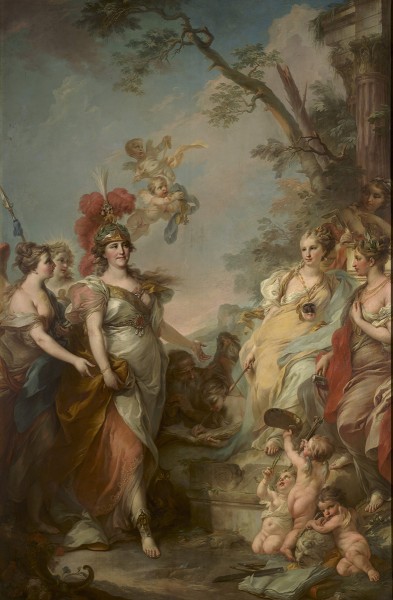The artist is Torelli

Catherine II, as well as other Russian monarchs, in poetic works directly or indirectly identified with the deity. The image of the empress was mostly associated with mythological images, with the names of virtues: Minerva – the goddess of wisdom and strength, Femis – the goddess of justice and justice. The name of Minerva combined the qualities of a warrior, not inferior to the valor of Mars, and the wise of the patroness of sciences and arts.
The picture was written by the Venetian painter Stefan Torelli, who came to Russia in 1762. Adherent of the decorative rococo, he quickly and equally talentedly wrote portraits and magnificent allegorical compositions, painted ceiling and walls of palaces.
Catherine II is depicted in the form of the goddess of the wisdom of Minerva, in armor and helmet, with an owl accompanying her, a symbol of wisdom. Three female figures, as well as three cupids represent “three noble art” – painting, sculpture and architecture. Two female figures on the left are the allegories of the world and war, in the center – the Muse of the History of Klio, leading historical records, and Saturn with a scythe person who personifies the time not powerful over the acts of the empress, recorded in the book of history. Above the head of Catherine Putti, carrying Order stars and medals of the Academy of Arts on blue ribbons.
Ekaterina II (Great; 1729-1796)-nee Princess Sofia Augustus Frederick the Angalt-Tserbst. Born in the German city of Stetin. In 1744, she arrived in Russia as the bride of Grand Duke Peter Fedorovich, the future Emperor Peter III. In the same year she accepted Orthodoxy with the name of Ekaterina Alekseevna and was married to Peter Fedorovich in August 1745. In 1754 she gave birth to an heir, future emperor Paul I. She did not work out with her husband, and Peter III intended to send his wife to the monastery. In the summer of 1762 she headed the guards and overthrew Peter III, becoming an empress. In the early years of government, it adhered to politics "enlightened absolutism", But after the peasant war, led by Emelyan Pugachev (1773-1775) and the great French bourgeois revolution (1789), she was forced to tighten the regime. Woned the victorious wars with Turkey (1768-1774; 1787-1792) and Sweden (1788-1790). During its reign, Russia included Crimea (1783), North Black Sea region, Baltic states, eastern parts of Poland, Aleutian Islands, Russian settlements in Alaska were created, Eastern Georgia was taken under patronage. The prestige of Russia in Europe has grown many times. Olga Savenkova. Exhibition catalog in Malaga "The Romanov dynasty". 2017. With. 229.
Leave a Reply